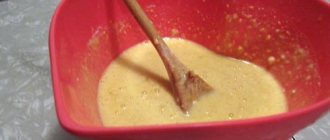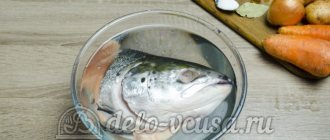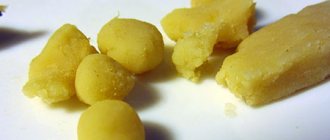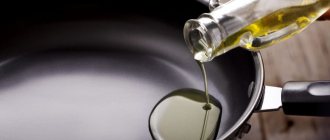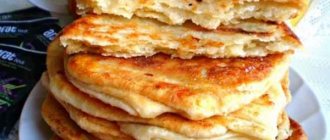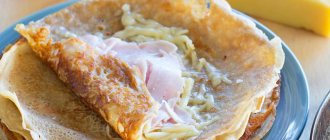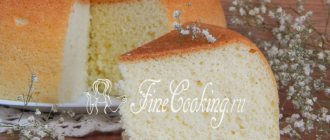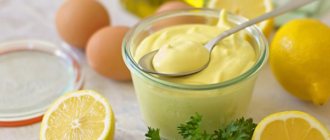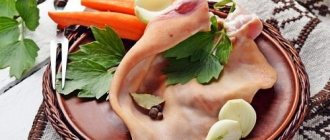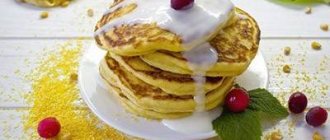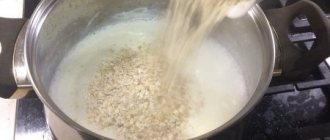Not every housewife has accurate scales in the kitchen that can be used to measure the required amount of product, but many have a glass that can also be used for these purposes. At the same time, however, when you see in a recipe the designation of the required amount of product in glasses, you should keep in mind that we are talking about a very specific type of this container. The fact is that today you can find a wide variety of glasses in tableware stores. However, when it comes to using this measure in culinary recipes, in most cases we are talking about a standard cut glass. It is quite easy to recognize: it has an even number of edges, and the top edge is made in the form of a smooth circle. The boundary between the faceted and smooth parts of the glass is called the marks.
A glass of flour
The glass is used in cooking for measuring in two ways.
On the one hand, it is used as a measure of volume when measuring the required amount of liquid. On the other hand, it is used as a measure of weight when dealing with solid or bulk products. For example, using a glass is one way to measure the right amount of flour. It is worth keeping in mind that the weight of the product in the glass will naturally depend on the degree of its fullness. The fact is that in culinary recipes there are two main options for filling a glass: to the top and to the top. Of course, the weight of the final amount of flour in these cases will be different, so you need to pay special attention to what kind of glass filling option is being discussed in a particular recipe.
So, if it involves filling the glass up to the risk, then the total weight of this amount of flour can be 130-140 grams. The fact is that this weight can fluctuate depending on the type of flour you use, since it can be, for example, wheat, rye or buckwheat. In addition, the humidity of the product has an influence on this parameter: for example, flour that was stored in a room with a high level of humidity most likely absorbed some moisture from the air and may weigh a little more than flour that was stored in a dry place. indoors. If the glass needs to be filled to the top, then the final weight of the product will be 150-160 grams in this case.
When planning to pamper their family with a delicious homemade dessert, many housewives wonder how many grams of sugar are in a glass. After all, if the recipe indicates the amount of refined sugar in grams, but there are no kitchen scales, you can seriously violate the recipe and the dish will noticeably lose in taste, or it will not work out at all. Or, on the contrary, the recipe indicates how much to take, for example, faceted glasses of sugar, but to accurately calculate the calorie content of a dessert, you need information about the amount of sugar in grams. In fact, 1 glass of sugar - how many grams it contains is not difficult to calculate. Calculations can be made on the most suitable container, and then take it as a standard.
How to measure sugar with a spoon?
Spoons are the most affordable cutlery. Every housewife has them and in every kitchen, so this measurement method is used most often. But even among tablespoons there are differences. Depending on what the device is intended for (soup, broth or sauce), the diameter and depth differ. To measure the exact amount, you should carefully examine the appearance of the cutlery.
- An ordinary soup spoon, with a diameter of 19–21 cm, holds 25 g of sugar, which means 4 pieces are needed for 100.
- The diameter of the sauce spoon is 18-19 cm, it contains 23-24 g, that is, 4.2 will be required.
- The size of a bouillon spoon is smaller, it is 16–17 cm, granulated sugar will hold 20 g. To measure 100 g with a bouillon device you need 5 spoons.
- The dessert spoon has a volume of 10 cm, which holds 14 g of sugar.
- A teaspoon with a diameter of 5 cm contains 7 g of granulated sugar.
| Weight(gram) | Type of spoon and quantity (with a small slide) | ||
| Canteen(20-25g) | Dessert(14 g) | Tea(7 g) | |
| 100 | 4-5 | 7 | 14 |
| 150 | 6-7,5 | 10 | 21,5 |
| 200 | 8-10 | 14 | 28,5 |
| 300 | 12-15 | 21 | 42 |
Important! A heap in a tablespoon gives a difference of 5 g, in a dessert spoon – 4 g, and in a teaspoon – 3 g.
What glasses are used to measure the weight of granulated sugar?
How much a glass of sugar weighs in grams depends on the type of glass, its volume, the presence/absence of a rim, and even the period of production. For example, faceted glasses produced in the USSR always had a certain volume - 250 milliliters. A variety of original-shaped dishes that are produced today cannot boast of such “stability.” As a measuring container, in the absence of special containers, you can use:
- A regular glass with smooth edges (its volume may vary)
- Faceted glass with rim – 250 ml
- Plastic cup - 200 milliliters
- Beaker
Product replacement table
- 1 tablespoon of wheat flour - 20/30g.
- 1 tablespoon of sugar - 13/26g.
- 1 tablespoon of powdered sugar - 14/28g.
- 1 tablespoon extra salt - 14/18g.
- 1 tablespoon of rock salt - 20/25g.
- 1 tablespoon of baking soda - 22/28g.
- 1 tablespoon of rice - 20/25g.
- 1 tablespoon of ground coffee - 15/20g.
- 1 tablespoon of honey - 25/30g.
- 1 tablespoon of granulated gelatin - 10/15 gr.
- 1 tablespoon of dry yeast - 8/11g.
- 1 tablespoon cocoa - 20/25g.
- 1 tablespoon of cinnamon - 15/20g.
- 1 tablespoon of citric acid in crystals - 12/16g.
- 1 tablespoon of water - 18g.
- 1 tablespoon of vinegar - 18g.
- 1 tablespoon of whole milk - 18g.
- 1 tablespoon of vegetable oil - 16g.
- 1 tablespoon melted margarine - 15g.
- 1 teaspoon of flour - 9/12g.
- 1 teaspoon of sugar - 5/8g.
- 1 teaspoon of citric acid - 5/8g.
- 1 teaspoon of cinnamon - 5/8g.
- 1 teaspoon cocoa - 6/9g.
- 1 teaspoon of dry yeast - 2.5/3g.
- 1 teaspoon of ground coffee - 4/7g.
- 1 teaspoon extra salt - 7/10g.
- 1 teaspoon of rock salt - 8/12g.
- 1 teaspoon of citric acid - 5/8g.
- 1 teaspoon of rice - 5/8g.
- 1 teaspoon of gelatin - 5/8 gr.
- 1 teaspoon of honey - 10/12g.
- 1 teaspoon of water - 5g.
- 1 teaspoon of vinegar - 5g.
- 1 teaspoon of citric acid - 5/8g.
- 1 teaspoon of whole milk - 5g.
- 1 teaspoon of vegetable oil - 5g.
- 1 teaspoon melted margarine - 5g.
- 1 glass of water - 200/250g.
- 1 glass of vegetable oil - 180/225g.
- 1 glass of ghee - 190/240g.
- 1 glass of cream - 210/250g.
- 1 glass of sour cream - 210/250g.
- 1 glass of wheat flour - 130/160g.
- 1 glass of sugar - 190/240g.
- 1 glass of salt - 200/250g.
- 1 glass of rice - 190/240g.
- 1 cup of walnuts - 140/150g.
- 1 glass of honey - 280/350g.
- 1 small egg - 50-55g.
- 1 yolk - 15g.
- 1 protein - 35g.
- 1 medium-sized egg - 55-65g.
- 1 large egg - 65-70g.
- 1 medium sized tomato - 100g.
- 1 potato - 150-200g.
- 1 medium-sized onion - 150g.
- 1 apple or pear - 100-150g.
- 1 clove of garlic - 5g.
- 1 medium lemon - 75 - 100g.
- 1 kg. soy flour = 1 kg. wheat flour
- 1 kg. butter = 850g. ghee
- 1 l. whole milk = 0.1 l. powdered milk powder
- 1 l. whole milk = 0.4 l. condensed milk
- 1 lemon = 10 g. citric acid
- 1 kg. molasses = 750 g sugar
- 0.1 l. rum or cognac = 10-15 g of rum essence
And finally, I want to quote a very good statement, especially since it fits the topic perfectly: Great masters of the art of cooking claim that the success of a dish depends 40% on the quality of the products, 20% on how good the recipe itself is and the rest on talent and the accuracy of the one who cooks.
Alena Khokhlova
www.good-menu.ru/articles/skolko-gramm.html
How many grams of sugar are in a faceted glass?
This container holds 250 milliliters. Bulk substances have a relatively large weight, but there are many voids between the sugar crystals. Therefore, the weight of a glass of sugar is slightly less than the volume of a glass of water.
There is a special strip on the top of the faceted glass, designed specifically for the most accurate measurement of volumes; the container is usually filled along this line - unless the recipe specifies that you need to take a heaped glass of sand. In such a glass, 160 grams of granulated sugar is placed up to the strip. If you pour refined sugar into a glass up to the very edge, it will be 200 grams. product. Due to the fact that it is a round number, it is easy to measure grams in halves and quarters of glasses.
- 100 gr. sugar - half a glass (to the edge)
- 0.5 faceted glass - 80 grams of sugar (to strip)
- 1/3 cup of sugar is 57 grams poured to the strip and 67 grams poured to the edge
- 200 grams of sugar is a full, faceted glass to the brim
Weight of sugar in spoons and glasses
heaping teaspoon of sugar weighs 8–9 grams.
Sugar should be collected carefully to get the largest possible pile.
* Weight tables give the value: 10 g .
A teaspoon of sugar “ with a mound ” weighs 6–6.5 grams.
A heaping tablespoon of sugar weighs 22–24 grams.
To get a spoonful of sugar like this, you need to scoop it deep into the sugar bowl and carefully remove the spoon so as to get the largest possible pile.
* Weight tables show the value: 25 g .
heaped tablespoon of sugar weighs 13–14 grams.
To get this weight, you need to scoop up the sugar and shake off the excess sugar so that this spoon can be comfortably carried across the table at arm's length or from room to room without spilling a crumb.
A full faceted glass of sugar, filled to the brim, weighs 200 grams.
How many grams of sugar are in a 200 ml glass
So, we found out how many grams of sugar are in a 250 ml glass - let us remember that we are talking about a “Soviet” faceted glass. But today not every housewife has such a model. And to determine the weight of a product in any other glass, you first need to know its volume. When purchasing a container, pay attention to the price tags - this way you will find out not only its cost, but also its volume. If the product was purchased a long time ago, but the packaging is still there, look for information about the volume there.
Most often, such glasses have a volume of 200 milliliters. It will hold approximately 160 grams of granulated sugar.
If you have a measuring cup, but you are too lazy to take it out often, pour a full, but without a slide, a regular glass of sugar, and then pour the contents into the measuring cup. Look at the weight of the product and write the result in your cookbook, or directly on the glass. Over time, you will remember this number, and the “cheat sheet” will no longer be needed.
How to measure sugar with a measuring cup: volume in ml and weight in grams
If you have a plastic measuring cup at home, you can measure the weight of sugar in the measuring cup. To convert milliliters to grams, you need to multiply the required number of milliliters by a factor of 0.8. If the weight in grams is multiplied by a factor of 1.25, we get the volume in milliliters.
- Volume 50 ml = 40 grams of sugar;
- 100 ml = 80 g;
- 125 ml = 100 g;
- 150 ml = 120 g;
- 200 ml = 160 g;
- 250 ml = 200 g;
- 500 ml = 400 g;
- 1 liter = 800 grams.
We suggest you read How to get rid of slugs in the house
How to measure the weight of sugar if the volume of the glass is unknown
If it is impossible to find information about the volume of capacity you have, you can use one trick. After all, a glass can have a volume of 200, 250 or even 300 ml, especially if it is a stylish container of a non-standard shape. Take the container whose volume you want to determine. Pour 7 tablespoons of sugar into it - always heaped. If the glass is completely filled, it means that it contains approximately 160 grams of product. If 8.5 tablespoons of granulated sugar fit into the container, then 200 grams can be placed in it. Thus, a tablespoon holds 24 grams of product. If the glass turns out to be even more spacious, continue pouring granulated sugar into it by teaspoons, not forgetting to write down how many spoons “got in.” After the glass is filled, make a notch and write the resulting number.
Usually the recipe specifies the number of level cups of sugar. Therefore, for more accurate measurements, after pouring granulated sugar into the container, run a knife along the top. The “extra” part of the refined sugar will be removed and it will be much easier to calculate the weight of the product.
Results
should be poured into a teaspoon or tablespoon possible , then its weight will correspond to the table (10 and 25 g). But our measurements showed that in reality, a teaspoon holds 1–2 grams less, and a tablespoon holds 2–3 g less. For most recipes, this difference is not important, but for a person it is only beneficial. Firstly, with numbers of 10 and 25 g it is much more convenient to count. Secondly, this way you will add and eat a little less sugar, and this will undoubtedly result in benefits for your health.
Types of glasses
There are several types:
- Faceted -
was developed for sailors during the reign of Peter I - during the rocking, the vessel tipped over, but did not roll off the table due to the characteristic arrangement of the edges. In the modern world, this type of vessel is widely used in public catering and on trains, since due to its structure it is stronger than its counterparts. It holds a traditional Soviet glass of 250 ml, and up to the risks (strips) – 200 ml. - Measuring
is used to measure solids or liquids during cooking. Typically its minimum capacity is 200 ml. - Old fashion
is used for alcoholic drinks with a large number of ice cubes in the composition, it can hold 300 ml. It is made of thick glass to prevent the rapid melting of ice. In the culinary business, Old Fashion is not used to measure the quantity of products. - Collins
is designed for alcoholic drinks with a significant volume - as it holds as much as 350 ml, and the container has a cylindrical shape. Not used in culinary recipes.
How to measure flour, sugar, salt without scales
We hope the tables will be so useful that you will no longer have questions about how many grams are in a spoon of a particular product.
When preparing new dishes, each of you has definitely encountered a situation where you need to accurately measure the amount of certain ingredients. Very often in recipes, and indeed in any cooking instructions, they give only general information, using terms like “a tablespoon of flour” or “a glass of buckwheat.”
That is, measurements in grams, kilograms or milliliters are omitted. But if you think about it, can you immediately tell how much a couple of drops of lemon juice, a teaspoon of mustard or vanillin weighs on the tip of a knife? After all, depending on the correct ingredients, your dish can turn out to be either very tasty or completely unsuitable for food. How many grams of salt are there? Any housewife or cook should know the answer to this question without hesitation, because the taste of your soup or main course greatly depends on the lack or excess of this ingredient.
Salt is not a component that can be added by eye, that is, as much as you think is necessary. You need to add exactly as much as indicated in the recipe. So, today in our article we will once and for all answer the question of how many grams of salt are in a tablespoon. You will also be offered a table for converting products from volume measures (tablespoons and teaspoons) to weight measures (grams) and vice versa. You can print it out and keep it in the kitchen so that if you have any doubts, you can immediately find out the exact answer. After all, not everyone and not always have kitchen scales at hand, which also take up enough space. The proposed table is a good alternative to this
We answer the question about how many grams of salt are in a tablespoon
So, remember once and for all: one tablespoon holds 25 grams of white small crystals. Therefore, for example, if when preparing pickles you need to put 50 grams of salt, then feel free to put 2 tbsp. no slide. These measurements are correct when the length of the spoon is 7 cm and the width is 4 cm, because the utensils may be different in each kitchen, so also take into account a slight error when introducing the ingredient into the dish. Taste the dish several times during the cooking process. But keep in mind that if we answer the question of how many grams are in a tablespoon of coarse salt, then there will already be a different value - 20 grams. And if you take a heaped spoonful of regular salt, its contents will already weigh 30 grams. It's that simple. This will help in the future to add exactly the amount of seasoning required by the recipe, because what could be worse for the housewife than an over-salted dish, the taste of which is sometimes very difficult to correct?
Conversion table (spoons - teaspoons and tablespoons) into weight measures (grams)
When you already know how many grams of salt are in 1 tablespoon, it is very useful to keep in mind the measurements of other foods often used in the cooking process.
We hope that our article was useful to you, and the question of how many grams of salt are in a tablespoon will no longer arise. We remind you: 25 grams of regular salt are in 1 tablespoon; 20 grams, if you take large crystals, and if you like to pour in heaps, then the weight of the ingredient will amount to all 30 grams. Take this into account and do not over-salt your dishes.
Very often, many culinary recipes indicate the exact amount of an ingredient needed to prepare a dish. But not every housewife has special kitchen scales in her kitchen.
If such equipment is not available in your home, do not despair. You can measure the required amount using a teaspoon, dessert or tablespoon.
Note!
But it is worth considering that the quantity will depend on the component itself. It all depends on the severity and density of the ingredient. Therefore, cutlery filled with different components will weigh differently.
A tablespoon is a cutlery. Its volume is 18 milliliters. This cutlery is used for eating porridge, first courses or other liquid culinary delights.
If you need to weigh a particular product, you should take into account the density of the ingredient and the “load” of the cutlery. The weight with and without a slide will vary from 4 to 6 grams.
The most common ingredients in the kitchen required to prepare a dish are sugar, flour and salt. Therefore, it is necessary to know the measurements of these products.
Table: measure of measurement.
Table: measures of other ingredients necessary for cooking.
| How many grams are in cutlery | Without slide (in gr.) | With a slide (in gr.) |
| Baking powder | 15 | 20 |
| Raisins | 15 | 20 |
| Dried mushrooms | 10 | 15 |
| Milk | 18 | 24 |
| Powdered milk | 20 | 25 |
| Cream | 14 | 18 |
| Tea | 6 | 11 |
| Citric acid | 25 | 30 |
| Jam | 18 | 24 |
| Protein | 15 | 19 |
| Rice | 25 | 30 |
| Perlovki | 25 | 30 |
| Millet cereal | 25 | 30 |
| Wheat cereal | 25 | 30 |
| Wheat flakes | 9 | 15 |
| Corn grits | 25 | 30 |
| Barley groats | 25 | 30 |
| Sago grains | 20 | 25 |
| Beans | 30 | 35 |
| Peas | 25 | 30 |
| Powdered sugar | 25 | 30 |
| Sunflower oil | 25 | 30 |
| Buckwheat | 25 | 30 |
| butter | 25 | 30 |
| Flax seeds | 16 | 23 |
| Tomato paste | 30 | 35 |
| Bran | 4,5 | 7 |
| Lentils | 25 | 30 |
| Hercules | 12 | 18 |
| poppy | 18 | 23 |
| Condensed milk | 48 | 55 |
| Copper sulfate | 65 | 75 |
| Flaxseed oil | 25 | 30 |
| Cottage cheese | 40 | 47 |
| Cinnamon | 20 | 25 |
| Coffee | 20 | 25 |
| Vinegar | 16 | 21 |
| Cocoa | 15 | 20 |
| Oatmeal | 12 | 18 |
| Liqueur | 20 | 25 |
| Corn flakes | 7 | 13 |
| Mayonnaise | 45 | 50 |
| Ground crackers | 15 | 20 |
| Oatmeal | 18 | 22 |
| Monkey | 30 | 35 |
| Gelatin | 15 | 20 |
| Water | 18 | 23 |
| Soda | 29 | 35 |
| Starch | 12 | 15 |
| Sour cream | 18 | 24 |
| Egg powder | 16 | 20 |
| Dry yeast | 16 | 20 |
| Fresh yeast | 45 | 55 |
| Vegetable oil | 25 | 30 |
| Ghee | 25 | 30 |
| Melted margarine | 20 | 25 |
| Ground black pepper | 12 | 15 |
| Rye flour | 25 | 30 |
| Ground walnuts | 30 | 35 |
| Ground peanuts | 25 | 30 |
| Ground hazelnuts | 30 | 35 |
| Ground almonds | 30 | 35 |
Honey is often used in many dishes. This is a very allergenic product, so it is worth knowing how many grams of honey are in a tablespoon so as not to exceed its permitted dose. One spoon contains 30 g. honey, provided that it is of liquid consistency.
Tables like these help in the kitchen. They relieve women from the need to purchase unnecessary kitchen appliances and clutter up the kitchen space. This significantly saves a woman’s time, physical effort and financial resources.
How much sugar is in a faceted glass
Sugar has a fairly large weight due to the chemical structure of its molecules (the molar mass of one molecule is approximately 343 g per mole).
However, bulk refined sugar in a mug weighs slightly less than water due to the physical structure of the molecules: the distances between them are so large that atoms can penetrate them.
In order to find the mass of a sweet substance in a faceted vessel, you need to know its density and volume. Before the marks (strips), this vessel holds 200 ml, in the SI system - 200 cubic cm.
Density of sugar from the food density table: 0.8 g per cubic cm. To calculate the mass, you need to multiply the density by the volume: 200 * 0.8 = 160 g. It turns out that in one two-hundred-milliliter faceted vessel there are 160 g of sweet substance.
2, 3, 4, 5 glasses of sugar - how many grams?
In order to find out how many grams of sweet substance are in a container, you can follow the same algorithm as when calculating the number of grams in a certain volume of container.
For calculations, you need to take into account the filling capacity of a standard faceted vessel - 200 ml = 200 cm cubic. One glass contains 160 g of refined sugar, that is, two glasses have 2 times more - 320 g, three glasses - 480, etc. Table of correspondence between the number of containers and the mass of refined sugar in them:
| Number of glasses | Granulated sugar, g |
| 1 | 160 |
| 2 | 320 |
| 3 | 480 |
| 4 | 640 |
| 5 | 800 |
| 6 | 960 |
How to measure 200, 250, 300 grams of sugar
To correctly calculate how many vessels are required for a specific mass of a sweet substance, you need to know a simple formula: to find the volume, you need to divide the mass by the density.
When dividing 200 g of sugar by the table density value (0.8 g per cubic cm), you get 250 cm cubic (or 250 ml). This value corresponds to the capacity of a fully filled faceted Soviet container.
Similarly, you can calculate the number of glasses that will be required for 250 g of sweet substance. 250 g of granulated sugar occupy 312.5 cubic cm, which corresponds to filling two vessels: the first should be completely filled, and the second only a quarter.
300 grams of granulated sugar occupy 375 cubic cm. For this volume, you need to take 2 faceted glasses: the first filled to the top, and the second only half filled.
The correct amount of each ingredient is very important in cooking: if you change the proportions of water and flour when baking bread, the dough may not rise or, on the contrary, have a too watery structure.
To determine the mass of bulk products, you can use information about how many milliliters each container can hold.
To determine the weight of bulk products, you can use the physical formula: mass equals density multiplied by volume.
The density of the substance can be found from a table on the Internet, and the capacity of the vessel should already be known to you, for example, the capacity of a tablespoon is 15 ml, a teaspoon is 5 ml.
If you don't have a cut glass, but have a kitchen scale, take a regular cup and use the scale to measure and mark the 200 or 250 ml line - whichever is convenient for you.
Flour is one of the most important and basic products in cooking. Pancakes, pancakes, pies, cakes, pastries - flour is an essential ingredient in many dishes. In order to prepare it correctly, it is necessary to measure the amount of each ingredient with maximum accuracy.
Any housewife, even the most experienced one, sooner or later is faced with the need to measure out 100 or 150 g of flour. Of course, if there are special scales in the kitchen, no problem arises. If they are missing, you can use a regular faceted glass. But for this you need to know exactly how many grams of flour are in a glass.
Tips for determining the mass of bulk products
Those who love and know how to cook are often faced with the need to determine the weight of a particular ingredient included in a recipe. This is very easy to do using regular scales. But today we are talking about how to do without measuring instruments.
To determine the mass of any bulk product, you can use various available means with a known measure of weight, such as:
- tea spoon;
- tablespoon;
- cup;
- tea cups;
- glass jars of various capacities.
The list goes on, and each housewife has her own tricks and devices. In this case, you can always use the table, which contains data on the weight of various products in any volume.
Faceted glass - how much flour is in it?
In order to find out how many grams of flour are in one glass, you should pour the product to the edges of the bowl, but without a slide. The resulting weight will be as follows:
- A glass of 200 ml holds 130-135 grams of flour.
- A 250 ml glass holds 160 grams of flour.
A 200 ml faceted glass holds 130 grams of flour. In this case we are talking about wheat flour. How many grams of flour are in two glasses? Accordingly, two 200 ml glasses contain 260 grams of product, and 250 ml glasses contain 320 grams of flour.
When answering the question, how many grams of flour are in 1 glass, you must remember that the weight of this product depends on what exactly it was made from. Wheat and corn flour are considered lighter, potato flour is heavier. A faceted glass contains approximately 160 grams of potato flour.
How many grams are in a faceted glass and where it came from and how an ordinary faceted glass can be useful in everyday life.
In Soviet times, not a single kitchen, factory canteen or train could do without it. They still use it now.
How many grams of salt are in a heaped and unheaped tablespoon? Table
We cannot exist without salt; almost no recipe can do without it.
By the way, in my recipes for winter preparations I indicated the quantity in spoons, this has already been verified. The taste of the dish largely depends on the amount of salt, and it is important not to overdo it or add too much salt.
We have different types of salt: both fine and coarse; we can scoop it into a spoon with or without a top, so there are four options:
- fine salt without a slide in a tablespoon (so that the surface is even under the line) 23 grams
- fine salt with a large slide holds 28 grams
- coarse rock salt spoon holds 25 grams without top
- A tablespoon of coarse salt can be about 30 grams.
I did not include all the weight figures in the table, only approximate ones, perhaps the ones most often requested: 50 grams of salt - how many spoons is that, 100 grams, 20, 25, etc.
If there is no weight in the table, it is easy to calculate the number of spoons: the weight must be divided by the number of grams of salt in one spoon.
And look, the results are obtained in fractional numbers, so here you will have to navigate whether to take the salt with a heaped spoon or without a heap.
It’s impossible to say right away whether a tablespoon is how many grams. Products have different densities. If they occupy the same volume, their mass will be different. But, knowing the weight of basic products - sugar, flour, starch - you can immediately estimate the mass of food with a similar density. Then determining the weight ratio of cereals, liquids, dry herbs when preparing a dish according to a new recipe will not be difficult.
Bulk products
How many grams of salt are in a tablespoon depends on the degree of grinding. In 1 tbsp. A flat spoon holds 25 g of rock salt and 22 g of extra salt. The same feature applies to other bulk foodstuffs that differ in type. For example, 1 tablespoon of beet sugar weighs 25 g, and raw cane sugar weighs 17.3 g.
Table of weight of products measured in 1 tbsp. heaped spoon
| Product type | Weight, in g |
| rice | 20 |
| buckwheat | 15 |
| natural ground coffee | 20 |
| barley grits | 20 |
| gelatin powder | 15 |
| Black tea | 15 |
| cocoa powder | 15 |
| ground cinnamon | 20 |
| baking soda | 28 |
| starch | 12 |
| lemon acid | 25 |
| dry yeast | 11 |
| baking powder | 20 |
| powdered milk | 24 |
| oatmeal | 16 |
| crushed crackers | 20 |
| ground black pepper | 20 |
| raisin | 20 |
| dried mushrooms | 13 |
| split peas | 25 |
| pearl barley | 23 |
| bran | 7 |
| flax seeds | 20 |
| pearl barley | 30 |
| cottage cheese | 40 |
| beans | 33 |
| semolina | 23 |
| crushed nuts | 20 |
| dry grass | 10 |
| salt | 30 |
We invite you to familiarize yourself with the differences between the water rat and the muskrat.
What kind of animal is a muskrat ? To tell how many grams of flour are in a tablespoon, first determine its type. Corn and potato flour weigh 30 g each, and wheat flour - 25 g.
Previously, in order to add the required amount of cereal or salt, they used a culinary table of weights and measures of food supplies, after which the values were translated manually. Nowadays, many housewives have electronic scales in their kitchens. But when the batteries run out, sometimes they fail. So experienced cooks always check their veracity, remembering that 1 tbsp. l. sugar weighs 25, and buckwheat - 15 grams.
Liquid products
| Products | Weight, in g |
| honey | 30 |
| sour cream 30% | 25 |
| melted margarine | 15 |
| whole milk | 20 |
| vegetable oil | 20 |
| condensed milk | 30 |
| table vinegar | 15 |
| Cherry jam | 50 |
| liquor | 25 |
| cream | 25 |
| melted butter | 20 |
| tomato paste | 30 |
| mayonnaise (low fat) | 25 |
| liquid fat | 20 |
| goat milk | 13 |
Before you say how many grams of water are in a tablespoon, look carefully at the device. Many people have dessert spoons and tablespoons mixed in their kitchen cabinets. But at least half of the population both call them canteens. 1 classic menu spoon holds up to 18 g of liquid, a regular table spoon – 15 g, and a dessert spoon – 10 g.
Great-grandfathers of faceted
Several legends are associated with his birth. The famous Vladimir glassblower Efim Smolin gave Peter 1 new strong drinking vessel. It was a faceted glass (so that it would not roll off the ship's table during rocking). The king decided to check the quality and hit it on the floor with the words: “There will be a glass!” The vessel, of course, broke, but a tradition arose of breaking the dishes for good luck. In 1905, a still life depicting the skeleton of a herring, fried egg and the great-grandfather of a cut glass was exhibited at the Fabergé Museum in Baden-Baden.
Measuring capacity: How many grams in a faceted glass table
Housewives have long been doing without special measurements - they bake and cook, measuring out food in a glass.
Bulk products
This type includes sugar, buckwheat, flour and much more. If you are faced with a recipe that includes bulk products in grams, then this table will become useful in your kitchen.
| Product | Glass without rim, 200 ml | Glass with rim, 250 ml |
| Sugar | 160 | 200 |
| Rice | 185 | 230 |
| Buckwheat | 165 | 210 |
| Pearl barley | 185 | 230 |
| Bulgur | 190 | 235 |
| Couscous | 180 | 225 |
| Millet | 175 | 220 |
| Peas | 185 | 230 |
| Salt | 255 | 320 |
| Semolina | 160 | 200 |
| Corn flour | 145 | 180 |
| Wheat groats | 145 | 180 |
| Barley groats | 145 | 180 |
| Wheat flour | 130 | 160 |
| Pasta | 190 | 230 |
| Oat flakes | 80 | 100 |
| Powdered milk | 100 | 120 |
| Cornflakes | 50 | 60 |
| Hercules | 60 | 75 |
Liquids
Liquid has a relatively fixed volume, making it very difficult to measure in grams. However, the table below shows the products in detail in grams.
| Product | Glass without rim, 200 ml | Glass with rim, 250 ml |
| Milk | 200 | 250 |
| Water | 200 | 250 |
| Kefir | 200 | 250 |
| Cream | 200 | 250 |
| Yogurt | 200 | 250 |
| Liquor | 200 | 250 |
| Vinegar | 200 | 250 |
| Cognac | 200 | 250 |
| Sunflower/olive oil | 185 | 230 |
| Ghee | 195 | 240 |
| Melted margarine | 180 | 225 |
| Rendered fat | 195 | 240 |
Solid foods
This table approximately shows how many grams are in a faceted glass, because the exact content will depend on the size and type.
| Product | Glass without rim, 200 ml | Glass with rim, 250 ml |
| Small lentils | 175 | 220 |
| Candied fruit | 220 | 275 |
| Sunflower seeds | 135 | 175 |
| Pumpkin seeds | 95 | 125 |
| Beans | 175 | 220 |
| Whole peas | 160 | 200 |
| Ground walnut | 155 | 190 |
| Large lentils | 160 | 200 |
| Raisin | 155 | 190 |
| Fresh blueberries | 160 | 200 |
| Dried blueberries | 110 | 130 |
| Cherry | 155 | 190 |
| Gooseberry | 165 | 210 |
| Cranberry | 155 | 190 |
| Cherries | 130 | 165 |
| Currant | 145 | 180 |
| Peeled hazelnuts | 140 | 175 |
| Peanuts, shelled | 140 | 175 |
| Peeled almonds | 135 | 170 |
| Strawberry | 135 | 170 |
| Whole shelled walnut | 135 | 170 |
| Raspberries | 120 | 150 |
Products with viscous consistency
Let's now look at the last variety of food we have left.
| Product | Glass without rim, 200 ml | Glass with rim, 250 ml |
| Honey | 260 | 325 |
| Condensed milk | 240 | 300 |
| Berry/fruit puree | 280 | 350 |
| Boiled condensed milk | 280 | 350 |
| Jam/ Jam | 275 | 340 |
| Tomato paste | 240 | 300 |
| Cottage cheese | 200 | 250 |
| Mayonnaise | 200 | 250 |
| Sour cream | 210 | 265 |
And in 1918, on the canvas “Morning Still Life” by Kuzma Petrov-Vodkin, there was a 12-sided glass of tea. Although it could have a different number of sides, from 12 to 20. The invention of the upper rounded rim is attributed to the famous USSR sculptor Vera Mukhina (she also invented the beer mug). It is believed that a container of this shape was more convenient to wash in Soviet dishwashers. Mass production of glasses began on September 11, 1943 at the glass factory in Gus-Khrustalny.
Number of grams of flour in a tablespoon
Of course, most often we have to measure flour in glasses or even according to the “as much as it takes” principle, but there are cases when you need a more precise amount or you need very little flour in grams and then you have to use a tablespoon.
It holds 20 grams of flour without a slide, and 30 grams of flour with top.
Almost all novice cooks are at a loss when it comes to preparing a dish according to the directions in the recipe. It’s good if the quantity of products is indicated in Art. or teaspoons. Difficulties arise when the recipe contains grams. But there is a way out, and even several:
- Cooking calculator. This is a convenient service in which you need to specify grams and get the equivalent in glasses, spoons, etc. For example, to understand how many st. l. is 40 grams of flour, it is enough to indicate the type of product and its weight in the appropriate columns, and the calculator will determine its quantity in a century in a matter of seconds. l.
- Culinary table of measures. The table shows grams of salt, cereals, flour, vanilla, which most often have to be measured when preparing dishes. And in the column on the left the amount of st. corresponding to the weight is written. l.
Culinary table of measures
| Products | Weight | Number of st. l. |
| salt | 25 grams | 1 without slide (b/g) |
| 40 g | 1 b/g plus ½ s/g | |
| sugar | 20 gr | 1 b/g |
| 80 grams | 4 b/g | |
| vinegar | 10 grams | 2 (in tsp) |
| 15 g | 1 | |
| potato starch | 20 g | 1 b/g |
| 30 grams | 1 s/g | |
| water | 50 g | 3 |
| 60 g | 3 tbsp. plus 2 hours | |
| mayonnaise | 20 g | 1 b/g |
| 80 g | 2 s/g plus 1 b/g |
We invite you to familiarize yourself with Tomato “Blue”: characteristics of the variety and reviews from gardeners. Characteristics and description of the Blue Bunch tomato variety, its yield
No baked goods are complete without flour. To measure the required amount of product, you should remember that 20 grams of flour corresponds to 1 tbsp. l. b/g.
If the calculations seem complicated or relative, it is worth purchasing a measuring cup, or even better, an electronic scale. But even here it should be remembered that the weight of bulk hygroscopic products depends on air humidity. The higher it is, the more weight the powder products acquire.

